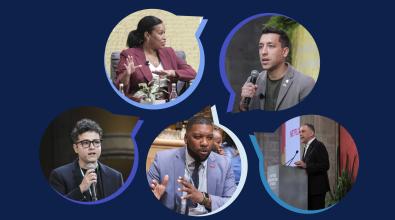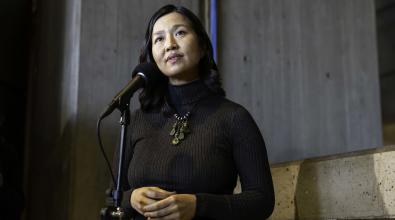Communicating in a pandemic: How cities can better reach non-English speakers

About 25 million U.S. residents are not fluid English speakers. During a public-health emergency in which clear communication is critical, cities are having a hard time reaching them with the critical information — and having an even harder time hearing back from these residents about their own needs.
What can cities do to strengthen communication with non-English speakers? That was the focus of a conversation among city leaders convened last week by What Works Cities. The challenges go well beyond translating press releases or tweets. There are also cultural barriers to contend with, mistrust of government among many communities, and the need for city leaders to be able to listen — and not just talk — in languages besides English.
While cities have struggled in this area for years, the COVID-19 crisis — and the disproportionate toll disease is taking among people of color — means leaders need to up their game. As What Works Cities’ Charlotte Carr, who hosted the discussion, explained: “You can’t curb a pandemic if you’re not involving every single member of your community in a two-way conversation.”
Here are five takeaways from the discussion.
Create a two-way dialogue. Cities today are better than they used to be at pushing out communications in multiple languages. But they’re not as good at the other side of the conversation — listening to what residents who don’t speak English are saying, hearing their needs and ideas, and responding to them.
Boulder, Colo., is trying a new approach through its Emergency Response Connectors program. The idea is the city has a small paid team of people who live or work within historically underrepresented communities. These “connectors” help to circulate and amplify key public health messages during the pandemic, such as the need to wear masks. Meanwhile, they keep an ear up for community news and needs and then relay that information back to city leaders in weekly meetings. The city first tested the concept while prototyping another idea as part of the Bloomberg Philanthropies Mayors Challenge and then scaled it up when the pandemic hit.
One of those Boulder connectors, Ana Casas Ibarra, said having this two-way dialogue has been critical during the COVID-19 outbreak. “We have been able to let them know the greatest needs of the community, which is financial, because so many families have lost jobs,” Ibarra said. As a result, she said, the city has targeted financial aid to key neighborhoods through its Health Equity Fund. “We feel very fortunate to have this in place because we now are feeling like the city is caring more about the community,” she said.
What the Boulder model shows, Carr said, is that a big part of the solution to local-government’s language problem lies with the very people living in the communities leaders are trying to reach. “There’s a tendency in City Halls to think it’s a burden to engage with so many different groups,” Carr said. Boulder is “recognizing that community members are partners you can look to for help and expertise and local knowledge.”
Think beyond Spanish. Many city language efforts only make it as far as Spanish. That’s a good start — Spanish is by far the most common language other than English spoken in the U.S. But at least 350 languages are spoken at home across the country, and the reality in many cities is that there are anywhere from a few to a few dozen others spoken by enough residents to warrant attention.
In Long Beach, Calif., there are at least two other critical languages besides Spanish, said Estefania Zavala, the city’s project lead for digital engagement. A large Filipino population speaks Tagalog, and a large Cambodian population speaks Khmer. Reaching Cambodians in a way that is culturally relevant has long been challenging. “The city has had a long history of not being able to translate into Khmer in a way that really makes sense and is accessible for those residents,” Zavala said.
“As city employees,” she continued, “we’re often looking for that one-to-one translation — this is what we do for English-speaking populations, now we’re going to do this for Spanish- and Khmer-speaking populations. And the reality is, it’s not that simple. You have to think of the very specific way you’re going to reach each.”
Build trust. In immigrant communities, language may not be the only barrier. People also may not trust the government, owing to bad experiences either before or after they came to the U.S.
Overcoming this takes time, however, and dedicated work forging strong relationships between City Hall and community-based organizations and leaders. “Cities that already had those connections and relationships in place before COVID-19 are faring better in terms of getting their public health message out in the community,” Carr said. “And those that did not have those relationships in place found themselves scrambling to catch up.”
Building trust is baked into Boulder’s model for community connectors, Ibarra said. “We are people within the community, so it’s not like we’re talking about that community over there,” Ibarra said. “No — it’s our community. It’s our friends, our family, our neighbors. I know their phone numbers and emails. That’s how we get information across. And since they know us, they trust the information we are giving them. They know that we’re connected to the city and that the information we’re giving them is accurate.”
It also pays to know what media outlets and local spokespeople are most respected within non-English speaking communities, said Adriana Garcia, associate director of immigrant affairs for the mayor’s office in Los Angeles. “Reaching out to the trusted newspapers, the trusted news channels, the trusted radio shows is very key here,” Garcia said. “But also using surrogates, whether it’s celebrities or people who are well known and respected, that people will pay attention to and trust.”
Tap into bilingual staff. In Los Angeles, some bilingual staff receive bonus pay to help translate communications. In an effort that began before the pandemic, the city is now collecting better data on its usage of staff who are certified in different languages. “Thankfully, we had that resource before COVID-19,” Garcia said. “Those individuals are receiving bilingual bonus pay already, and were helpful in quickly translating short messages for social media or quick public service announcements.”
Garcia said it’s especially helpful that Mayor Eric Garcetti speaks Spanish. “Whenever he’s delivering important messages on COVID-19 in English,” she said, “he’s able to translate it on the spot.”
Experiment. The need during the pandemic for more remote communication, rather than face-to-face, poses its own challenges. To get out public-health messages, cities are needing to try different things.
For example, Boulder is finding that Spanish-language text messages are better than email for reaching Latinx communities. For meetings that require language interpretation, Boulder is also using a translation feature in Zoom. “We’ve found it works really well,” said Ryan Hanschen, an engagement specialist with the city manager’s office. “Every time, I think it’s magic. It makes me feel like we’re living in the future.”
Cities also are trying to meet people where they are. Long Beach is passing out multilingual flyers to residents waiting in line to enter grocery stores, and tucking them into food boxes handed out at pantries. While the city also has had some success with online town halls, Zavala said, she can’t wait until the pandemic is over and face-to-face contact is easier. “A lot of communities are just really uncomfortable with technology, and you have to honor that,” Zavala said. “There’s no substitute for meeting people in person.”
Photo courtesy of Shutterstock


